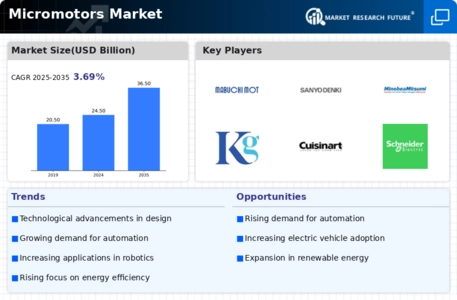Top Industry Leaders in the Micro Motors Market
*Disclaimer: List of key companies in no particular order
Exploring the Competitive Landscape of the Micro Motors Market
The Micro Motors Market is a dynamic and constantly evolving arena, shaped by technological advancements, trends in miniaturization, and rising demand across diverse industries. This growth not only brings forth opportunities but also poses challenges for major players, emphasizing the need for a comprehensive examination of their strategies within the overarching competitive landscape.
Strategic Approaches by Key Players:
Mabuchi Motor Co Ltd
Nidec Corporation
Buhler Motor GmbH
Johnson Electric Holdings Limited
Maxon Motor AG
Arc Systems Inc
ABB Group
Mitsuba Corporation
Constar Micromotor Co Ltd
Siemens AG
Product Diversification: Leading enterprises are broadening their product portfolios beyond the conventional DC and AC motors. They are now incorporating brushless DC (BLDC) motors, stepper motors, and micro servo motors to address specific requirements in applications like drones, medical devices, and robotics.
Technological Innovation: Sustained investment in research and development is pivotal for maintaining a competitive edge. Companies such as Johnson Electric and Faulhaber are concentrating on miniaturization, heightened efficiency, and improved power density. Faulhaber, for example, has engineered micromotors as compact as 1.9mm in diameter, catering to the needs of surgical tools and implantable medical devices.
Vertical Integration: Some players are opting for vertical integration, intertwining upstream and downstream activities to enhance control over the supply chain and reduce costs. This might involve in-house manufacturing of core components like magnets and windings or forging partnerships with material suppliers.
Geographic Expansion: Recognizing the substantial growth potential in emerging markets like China and India, companies are establishing manufacturing facilities and distribution networks in these regions. This strategic move allows them to effectively cater to local demands in these rapidly industrializing economies.
Focus on Sustainability: Environmental regulations and increasing consumer awareness are steering the development of energy-efficient micro motors. This involves incorporating elements such as rare-earth-free magnets, recycled materials, and technologies with low power consumption.
Factors Influencing Market Share:
Product Portfolio Breadth: Companies boasting a diverse range of motor types, power outputs, and functionalities are better positioned to meet varied customer needs.
Technological Expertise: A robust research and development team coupled with a proven track record of innovation is crucial for differentiation and sustaining a competitive advantage.
Manufacturing Capabilities: Efficient production processes, cost competitiveness, and stringent quality control measures play pivotal roles in gaining market share.
Brand Reputation: Established brands that enjoy a robust reputation for quality and reliability hold a significant competitive edge over new market entrants.
Distribution Network: A well-established distribution network and strong customer relationships ensure wider market reach and faster time-to-market for products.
Emerging Trends in the Micro Motors Market:
Integration with AI and IoT: Micro motors are increasingly being integrated with artificial intelligence and Internet of Things (IoT) technologies, offering enhanced control, real-time monitoring, and predictive maintenance, ultimately leading to improved performance and efficiency.
Biocompatible Materials: In the realm of medical and surgical applications, the development of biocompatible materials is crucial to ensure safety and minimize the risk of rejection within the human body.
3D Printing: Additive manufacturing is revolutionizing the design and production of micro motors, enabling the creation of complex geometries, customized designs, and on-demand manufacturing for niche applications.
Energy Harvesting: Micro motors powered by energy harvesting technologies, such as solar or piezoelectric cells, are gaining viability for remote and off-grid applications.
Overall Competitive Scenario:
The micro motors market is marked by high fragmentation, featuring a blend of established players and emerging companies. Intense competition prevails, encompassing aspects such as price, technology, and innovation. However, collaboration and partnerships are increasingly becoming vital as companies pool their expertise and resources to devise novel solutions tailored to specific applications.
Key Players and Recent Developments:
Johnson Electric: Strengthened its foothold in the high-precision micro motor market by acquiring Shenzhen Maxon Motor in 2023.
Faulhaber: Introduced a new line of BLDC motors with integrated encoders, enhancing precision positioning and control.
Nidec: Invested in startups specializing in microfluidic pumps and other micro-electro-mechanical systems (MEMS) technologies.
Mabuchi Motor: Focused on expanding production capacity in China and Southeast Asia to meet escalating demand.
ECM: Teamed up with a university to develop biocompatible micro motors specifically for medical devices.










